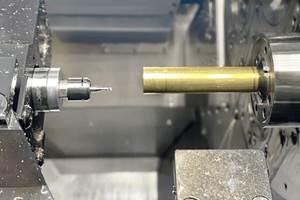Buying a Lathe: Spindles and Tailstocks
A key consideration when buying a new turning machine involves its spindle. Here’s an overview of what you need to know.
Share





After considering what sorts of workpieces your turning machine will need to handle, and taking a good look at tooling options, it’s a good time to cover what kinds of spindles lathes might have, and what factors are good to keep in mind when choosing a new machine.
Belt-Driven or Direct-Drive Spindles
The spindle on a turning center is either belt-driven or direct-drive. Generally, belt-driven spindles represent older technology. They speed up and slow down at a lower rate than direct-drive spindles, which means cycle times can be longer. If you’re turning small-diameter parts, the time it takes to ramp the spindle from 0 to 6,000 rpm is significant. In fact, it might take twice as long to reach this speed than with a direct-drive spindle.
A small degree of positional inaccuracy may occur with belt-driven spindles, because the belt between the drive and the positional encoders creates a lag. With integral direct-drive spindles, this is not the case. Ramping up and down with a direct drive-spindle happens at a high rate, and the positional accuracy also is high, a significant benefit when using C-axis travel on live-tooling machines.
A2 Spindle Noses
Lathes are designed to have an American Standard spindle nose on the front of the spindle motor. Tapered spindle noses come in various sizes to hold the chuck or threaded spindle mount. A2 and B2 are both short-taper spindles; the only difference between them is the method in which the chuck is mounted. Type L refers to long-taper spindles, and Type D features a camlock mounting used on many engine-lathe spindles.
The good news is, your machine tool manufacturer has the spindle nose selection worked out based on the size of the chuck, diameter of barstock you intend to machine and the horsepower needed. The spindle nose will be properly sized for the machine.
Spindle Speeds, Horsepower and Torque
Today’s CNC lathes are designed for specific ranges of stock diameters. Basically, you buy a machine to cut a specific, maximum workpiece diameter. If you’re cutting 2-inch-diameter barstock, the machine will be designed for running small diameters using higher-speed, 6,000-rpm spindles, and with the right amount of horsepower and torque.
Generally, big lathes have high torque (twisting power) due to the weight of the mass spinning in the chuck. As a rule, the bigger the workpiece and the slower the spindle speed, the more torque required.
If the parts you are running require a machine with a 10-inch, big-bore chuck, the spindle will be designed to deliver slower speeds at more horsepower. This creates the torque to take bigger cuts for more stock removal. As the cutter gets closer to the center of the stock, the machine will automatically speed up to, say, 700 rpm to maintain the proper surface footage. Obviously, it doesn’t make sense to use a big-bore lathe to do small-diameter work.
The operation that typically requires peak horsepower is heavy-duty, inner-diameter work, such as using big drills to make holes in the barstock before finish-boring. In this case, Z-axis horsepower might be the limiting factor. For example, a 2-inch drill may require a 20-hp spindle motor to get the force needed to perform this operation.
Programmable Tailstocks
A built-in, numerically controlled tailstock can be a valuable feature for automated processes. A fully programmable tailstock provides more rigidity and thermal stability. However, the tailstock casting adds weight to the machine.
There are two basic types of programmable tailstocks—servo-driven and hydraulic. Servo-driven tailstocks are convenient, but the weight they can hold may be limited. Typically, a hydraulic tailstock has a retractable quill with a 6-inch stroke. The quill also can be extended to support a heavy workpiece, and do so with more force than a servo-driven tailstock can apply. This is an advantage if you’re machining a piece that weighs, let’s say, 2,000 pounds. Using the programmable tailstock to push the part helps support its weight in the chuck.
This is part three of a four-part series about buying turning machines.
- Part one: Buying a Lathe: The Basics
- Part two: Buying a Lathe: Turrets and Live Tooling
Find more insights about acquiring a new machining center by visiting the Techspex Knowledge Center, “Guide to Buying Machine Tools.”
Related Content
3 Tips to Accelerate Production on Swiss Lathes with Micro Tools
Low RPM lathes can cause tool breakage and prevent you from achieving proper SFM, but live tooling can provide an economical solution for these problems that can accelerate production.
Read MoreFinding the Right Tools for a Turning Shop
Xcelicut is a startup shop that has grown thanks to the right machines, cutting tools, grants and other resources.
Read MoreTop Shops: Designing a Shop to Meet Customer Needs
Working closely with customers and making careful investments has enabled this Wisconsin machine shop to tackle difficult jobs with tight deadlines as a core part of its business.
Read MoreFacilitating Lean Manufacturing Through Modularity
Knowing how to subdivide machines and jobs has enabled Danobat to create a lean manufacturing process that improves its lead times by up to 25%.
Read MoreRead Next
Picking the Right End Mill
Kennametal global product manager Katie Myers explains how cutting tool features can impact machining strategies for different materials.
Read MoreWhy We Ask Machine Shop Leaders to Speak at TASC – The Automated Shop Conference
TASC is our industry’s premier peer-to-peer automation stage where America’s shop leaders refine the art of metalworking and CNC machining. For conference speakers, it's also an opportunity to showcase your skills and gain exposure for your business. Here are five why stepping into the spotlight at TASC could be your smartest move toward elevating your shop.
Read MoreSetting Up the Building Blocks for a Digital Factory
Woodward Inc. spent over a year developing an API to connect machines to its digital factory. Caron Engineering’s MiConnect has cut most of this process while also granting the shop greater access to machine information.
Read More





















.jpg;maxWidth=300;quality=90)







